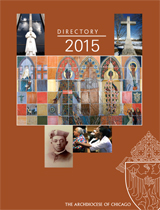Rolheiser discusses real faith, our deepest desires

A regular feature of The Catholic New World, The InterVIEW is an in-depth conversation with a person whose words, actions or ideas affect today's Catholic. It may be affirming of faith or confrontational. But it will always be stimulating.
Father Ronald Rolheiser needs little introduction. His writing is wellknown throughout the Englishspeaking world and his column is featured in more than 60 Catholic newspapers worldwide, including the Catholic New World.
During a recent visit to Chicago to speak at Dominican University’s Siena Center, he shared his insight on spirituality and faith in today’s society with staff writer Tania Mann.
Catholic New World: What ideas or images have you found most useful for reflection about the meaning of Lent?
Father Ronald Rolheiser, OMI: The Biblical image of the desert is my favorite image of Lent. First of all, Israel having spent 40 years there, but especially Jesus picking to go to the desert for 40 days and 40 nights and fasting. But I also like to draw from some rich anthropological images.
The whole thing about sitting in ashes, that’s in all cultures.
In the story of Cinderella, Cinder is ashes and ella is from the Latin puella or girl — so that’s the little girl who sits in the ashes. It’s an old tale, about 6,000 years old. Already it’s a story of Lent — before you get to go to the ball and dance with the prince you have to sit in the ashes, in a certain kind of humiliation, and do some deep inner work.
Also, in North American cultures, they had longhouses with logs and fire and the smoke would come out, and outside there would be a heap of ashes. And sometimes, for one reason or another — some people today might call it clinical depression — they’d go to sit in these ashes for a period of time.
No one would ask why, they just thought, “It’s their time to sit in the ashes.” And at a certain time they would get up, wash up and rejoin life. The idea was that we all just need to sit in the ashes sometimes to work through some inner chaos.
Then in mythology, there’s the idea that the planet Saturn is the mother of sadness, and at times she’s going to claim you as her child. During that time you’re going to be sad, but your mother’s teaching you something deep that you can only learn inside of sadness.
Another one, very simply — I love this one — is the idea that tears as a wonderful metaphor. It’s interesting that not a lot of salt water comes out of your body, but tears are salt water.
Remember, all life came from the ocean, so your tears are the water of life that connect you to the origin of life, and it’s the whole idea that there are certain things you learn in tears that you can’t learn in joy.
CNW: From your pastoral experience, how would you describe what it is that most people are seeking in life?
Rolheiser: If I ask you, “What do you really want?” — there are about five levels to you. I want this relationship, this job — those are very valid wants. Proximately, you have many different longings. Ultimately, we want God. All people are born with the same kind of basic hardware, but, when this starts breaking through — breaking through not abstractly, but breakthroughs like puberty.
An example — St. Thomas Aquinas was put in a monastery as a little boy. Then as a 13-year-old, he’s experiencing all these desires, but what’s he seeing? He’s hearing about longing for Jesus and Christ’s body. Another child is watching pornography. What kind of software are we putting in there? The software that you meet is very, very key.
The key moments of initiation are when you’re a baby and when you reach puberty — who’s your family, who’s around you, what’s around you — they’re very much going to set what you’re longing for.
But everybody’s longing for the same thing ultimately. We’re all longing, metaphorically, to see the face of God, to go to heaven — but that’s also an image.
Basically what you’re longing for, you’re longing for union, union with God, and not just with God, with other people, with the world, with your true self. You know you want to be in communion, your spirit wants to just flow out and make contact and just be everywhere and be together with everyone. That’s communion — communion with the cosmos, cosmological ecstasy — everybody wants that.
CNW: How do you see vulnerability as a part of your approach to ministry and how do you think it’s important?
Rolheiser: I’ll start with Jesus. When they talk about Jesus, they say he has power in his teaching, but the word they use, there’s no English word for it. The word they use is exousia — exousia is the power of vulnerability. That’s the power that a baby has in a room. If you put a baby and a football player into a room, who has ultimately more power?
Well, the football player can kill the baby, but the baby has a different kind of power — the baby has exousia — the baby has a power to change your heart. The word vulnerability is probably the closest we can get to that.
See, Hollywood heroes overwhelm you at the end. They out-gun, out-muscle everybody, and we get that mixed up with God.
It’s a different kind of power. It doesn’t overpower you with muscle or speed or grace, it underwhelms you and changes your heart.
To be powerful in any kind of ministry, you have to be vulnerable. You have to radiate a certain exousia. It’s taken us 2,000 years of Christianity, and we still haven’t quite got that, because we always want to get back to the power that overpowers.
CNW: What constitutes real faith?
Rolheiser: People often argue is faith the head or the heart? Do you get faith in an intellectual ascent, or is it really revealed by affective ascent of the heart? Real faith is real in your actions. Jesus says that. It’s not those who say “Lord, Lord” but those who do the will of the Father.
They turned out that book about Blessed Mother Teresa — faith in actions. Early on, her head was in it, heart was in it, and afterwards she felt like an atheist, but it didn’t matter. Head and heart cut in and cut out, but faith is real in your actions.
 Catholic
New World - Newspaper for the Archdiocese of Chicago
Catholic
New World - Newspaper for the Archdiocese of Chicago Archdiocese of Chicago Directory
Archdiocese of Chicago Directory Oficjalne wydawnictwo Archidiecezji Chicago w języku polskim
Oficjalne wydawnictwo Archidiecezji Chicago w języku polskim
